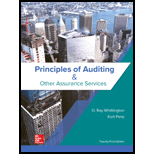
EBK PRINCIPLES OF AUDITING & OTHER ASSU
21st Edition
ISBN: 9781260299434
Author: WHITTINGTON
Publisher: YUZU
expand_more
expand_more
format_list_bulleted
Question
Chapter 17, Problem 25COQ
To determine
Identify how the reference to the component auditor in an audit report on the combined financial statement is made.
Expert Solution & Answer
Trending nowThis is a popular solution!

Students have asked these similar questions
Compare and contrast the procedures for lodging an objection in Jamaica with those of Trinidad and Tobago.
The actual cost of direct labor per hour is $16.25 and the standard cost of direct labor per hour is $15.00. The direct labor hours allowed per finished unit is 0.60 hours. During the current period, 4,500 units of finished goods were produced using 2,900 direct labor hours. How much is the direct labor rate variance? A. $3,625 favorable B. $3,625 unfavorable C. $4,350 favorable D. $4,350 unfavorable
On January 1 of the current year, Piper Company issues a 4-year, non-interest-bearing note with a face value of $8,000 and receives $4,952 in exchange. The recording of the issuance of the note includes a:
a. credit to Notes Payable for $4,952.
b. credit to Discount on Notes Payable for $3,048.
c. debit to Discount on Notes Payable for $3,048.
d. debit to Cash for $8,000.
Chapter 17 Solutions
EBK PRINCIPLES OF AUDITING & OTHER ASSU
Ch. 17 - Prob. 1RQCh. 17 - What is the function of notes to financial...Ch. 17 - Prob. 3RQCh. 17 - Prob. 4RQCh. 17 - Prob. 5RQCh. 17 - Prob. 6RQCh. 17 - Prob. 7RQCh. 17 - Prob. 8RQCh. 17 - Prob. 9RQCh. 17 - Prob. 10RQ
Ch. 17 - Prob. 11RQCh. 17 - Prob. 12RQCh. 17 - Prob. 13RQCh. 17 - Prob. 14RQCh. 17 - Prob. 15RQCh. 17 - Prob. 16RQCh. 17 - Prob. 17RQCh. 17 - Prob. 18RQCh. 17 - Prob. 19RQCh. 17 - Prob. 20RQCh. 17 - Prob. 21QRACh. 17 - Prob. 22QRACh. 17 - Prob. 23QRACh. 17 - Prob. 24QRACh. 17 - Prob. 25AOQCh. 17 - Prob. 25BOQCh. 17 - Prob. 25COQCh. 17 - Prob. 25DOQCh. 17 - Prob. 25EOQCh. 17 - Prob. 25FOQCh. 17 - Prob. 25GOQCh. 17 - Prob. 25HOQCh. 17 - Prob. 25IOQCh. 17 - Prob. 25JOQCh. 17 - Prob. 25KOQCh. 17 - Prob. 25LOQCh. 17 - Prob. 26OQCh. 17 - Prob. 27OQCh. 17 - Prob. 28OQCh. 17 - Prob. 29OQCh. 17 - Prob. 30OQCh. 17 - Prob. 31OQCh. 17 - Prob. 32OQCh. 17 - Prob. 33PCh. 17 - Prob. 34PCh. 17 - Sturdy Corporation (a nonpublic company) owns and...Ch. 17 - Prob. 36PCh. 17 - Prob. 37PCh. 17 - Prob. 38ITCCh. 17 - Prob. 39ITCCh. 17 - Prob. 40RDC
Knowledge Booster
Similar questions
- During September, the assembly department completed 10,500 units of a product that had a standard materials cost of 3.0 square feet per unit at $2.40 per square foot. The actual materials purchased consisted of 22,000 square feet at $2.60 per square foot, for a total cost of $57,200. The actual material used during this period was 25,500 square feet. Compute the materials price variance and materials usage variance.arrow_forwardBluesy Electronics recorded the following financial data: Net Sales $720,500 Average Inventory at Cost = $80,200 Gross Margin Percentage = 42% Calculate the GMROI.arrow_forwardNeed help this question solutionarrow_forward
- XYZ Company has a gross profit margin of 0.30, an operating profit margin of 18%, a total asset turnover ratio of 2.0x, and cost of goods sold of $700,000. The company's tax rate is 35%, and it has no debt. Calculate XYZ Company's Return on Assets (ROA).arrow_forwardMON Pools builds custom swimming pools. MON budgets that they will build 16 pools during the month of June at a price of $22,750 per pool. The actual pools built by MON during June were 13 pools at a price of $23,420 per pool. What is the Flexible Budget Variance for June?arrow_forwardAnderson Corp. pays its employees every Friday for work performed through that Friday. Anderson employees work Monday through Friday and do not work on weekends. The gross payroll for Anderson is $12,500 each week. Anderson will pay its employees $12,500 on Friday, May 8th. This payroll is for wages earned Monday, May 4th through Friday, May 8th. How much of the $12,500 paid on May 8th should be expensed in May?arrow_forward
arrow_back_ios
SEE MORE QUESTIONS
arrow_forward_ios
Recommended textbooks for you
 Auditing: A Risk Based-Approach to Conducting a Q...AccountingISBN:9781305080577Author:Karla M Johnstone, Audrey A. Gramling, Larry E. RittenbergPublisher:South-Western College Pub
Auditing: A Risk Based-Approach to Conducting a Q...AccountingISBN:9781305080577Author:Karla M Johnstone, Audrey A. Gramling, Larry E. RittenbergPublisher:South-Western College Pub Auditing: A Risk Based-Approach (MindTap Course L...AccountingISBN:9781337619455Author:Karla M Johnstone, Audrey A. Gramling, Larry E. RittenbergPublisher:Cengage Learning
Auditing: A Risk Based-Approach (MindTap Course L...AccountingISBN:9781337619455Author:Karla M Johnstone, Audrey A. Gramling, Larry E. RittenbergPublisher:Cengage Learning

Auditing: A Risk Based-Approach to Conducting a Q...
Accounting
ISBN:9781305080577
Author:Karla M Johnstone, Audrey A. Gramling, Larry E. Rittenberg
Publisher:South-Western College Pub

Auditing: A Risk Based-Approach (MindTap Course L...
Accounting
ISBN:9781337619455
Author:Karla M Johnstone, Audrey A. Gramling, Larry E. Rittenberg
Publisher:Cengage Learning
